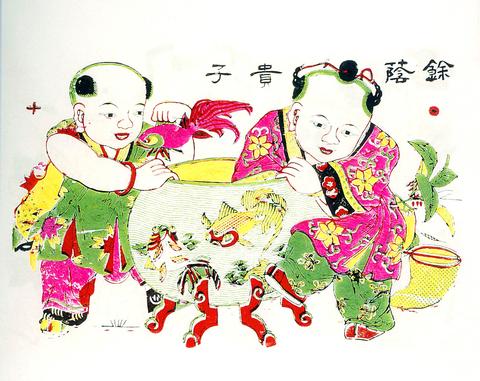The fish has long been an auspicious motif in Chinese folk culture. Often it is associated with the meaning of abundance, as in the Chinese New Year's phrase of "nien nien you yu" (年年有魚), in which the character for fish "魚" is a homonym of the character for surplus "餘." During Chinese New Year, paper cut-outs with a fish motif can be seen posted around traditional households to bring good fortune. But the fish motif is taken beyond its function as a folk holiday decoration to be the subject of many exquisite artistic creations, as seen in a current exhibition at the National Museum of History.
The museum spent nearly two years putting together about 150 items with a fish motif from its own collection, ranging from pottery and jade articles to paintings and prints. The oldest item is a Neolithic pottery bowl painted with twin fish, known to be more than 4,000 years old. There is a rich selection of pottery and jade articles from ancient China, while the paintings on display are mostly modern pieces. Two exhibits that are sure to surprise viewers are six fully-stocked fish tanks and the 11.5m-long skeleton of a baby whale on loan from the Penghu culture bureau.

PHOTO COURTESY OF THE NATIONAL MUSEUM OF HISTORY
The exhibits on view from the museum's own collection are divided into five categories -- art, religion, literature, folk customs and leisure.

PHOTO COURTESY OF THE NATIONAL MUSEUM OF HISTORY
In the art category, a major highlight are oil paintings by Chang Yu (常玉). Chang's Small Fish (小魚) and Fish (魚) both depict images of fish against a vast background, giving a lost and helpless feeling. Ink painting master Chang Da-chien (張大千) is also showcased with four paintings that use his trademark simple strokes to outline fish on silk and rice paper.
Many ancient cultures use animals and creatures as totemic figures during religious rituals. The pottery bowls from the Neolithic period show fish motifs in simple abstract forms, which provide an intriguing contrast to the more complicated and realistic designs of the modern Taiwanese chiao-chih pottery (交阯陶) items that are also on exhibit. Two interesting pieces are a pair of candle holders with dragon heads and fish bodies from the Ching dynasty.
The carp is the favorite among all fishes, as evidenced by the many small bronze and jade accessory items on display. Very often they are paired up in one design. In Chinese folk culture, fish symbolize good relations between couples and accessories with twin fish are good gifts for newly-weds. One of the more mysterious pieces is a Tang Dynasty gilt bronze belt ornament. Its fish pattern, with a monster head, is thought to have been imported from the West, as it resembles the Capricorn zodiac sign with a goat's head and fish's tail.
On specific occasions, paper cut-outs and colorful prints with fish motifs are appropriate gifts for married couples, as fish in these cases also symbolize abundance of offspring. Two prints on view that touch on this theme are Have Abundance Yearly (連年有魚) and Blessing Left to One's Children (餘蔭貴子), which blend images of children and fish.
Art Notes:
What: Exhibition of the Fish Symbolism in the Arts
Where: National Museum of History (國立歷史博物館), 49 Nanhai Rd., Taipei (臺北市南海路49號)
When: Until Sept. 23

June 2 to June 8 Taiwan’s woodcutters believe that if they see even one speck of red in their cooked rice, no matter how small, an accident is going to happen. Peng Chin-tian (彭錦田) swears that this has proven to be true at every stop during his decades-long career in the logging industry. Along with mining, timber harvesting was once considered the most dangerous profession in Taiwan. Not only were mishaps common during all stages of processing, it was difficult to transport the injured to get medical treatment. Many died during the arduous journey. Peng recounts some of his accidents in

“Why does Taiwan identity decline?”a group of researchers lead by University of Nevada political scientist Austin Wang (王宏恩) asked in a recent paper. After all, it is not difficult to explain the rise in Taiwanese identity after the early 1990s. But no model predicted its decline during the 2016-2018 period, they say. After testing various alternative explanations, Wang et al argue that the fall-off in Taiwanese identity during that period is related to voter hedging based on the performance of the Democratic Progressive Party (DPP). Since the DPP is perceived as the guardian of Taiwan identity, when it performs well,

A short walk beneath the dense Amazon canopy, the forest abruptly opens up. Fallen logs are rotting, the trees grow sparser and the temperature rises in places sunlight hits the ground. This is what 24 years of severe drought looks like in the world’s largest rainforest. But this patch of degraded forest, about the size of a soccer field, is a scientific experiment. Launched in 2000 by Brazilian and British scientists, Esecaflor — short for “Forest Drought Study Project” in Portuguese — set out to simulate a future in which the changing climate could deplete the Amazon of rainfall. It is

The Taiwan People’s Party (TPP) on May 18 held a rally in Taichung to mark the anniversary of President William Lai’s (賴清德) inauguration on May 20. The title of the rally could be loosely translated to “May 18 recall fraudulent goods” (518退貨ㄌㄨㄚˋ!). Unlike in English, where the terms are the same, “recall” (退貨) in this context refers to product recalls due to damaged, defective or fraudulent merchandise, not the political recalls (罷免) currently dominating the headlines. I attended the rally to determine if the impression was correct that the TPP under party Chairman Huang Kuo-Chang (黃國昌) had little of a